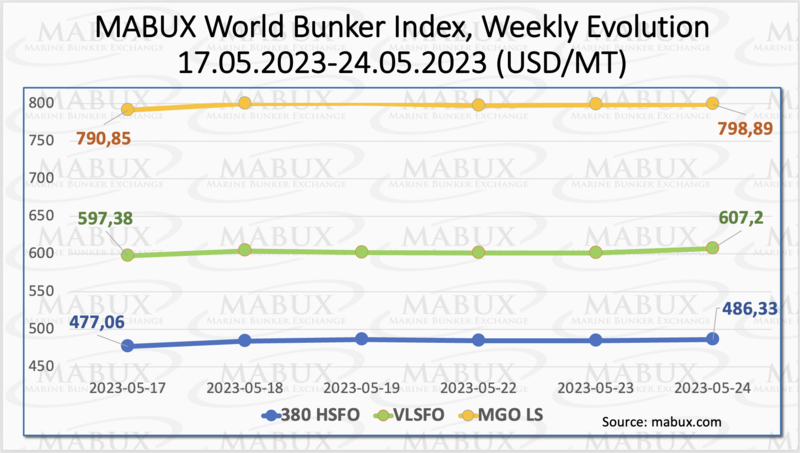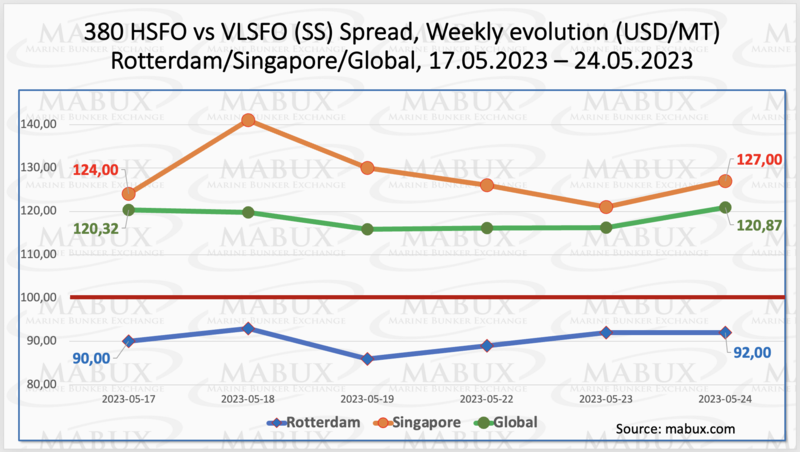The Weekly Outlook was contributed by Marine Bunker Exchange (MABUX)
Over the Week 21, the global MABUX bunker indices turned into an upward trend. The 380 HSFO index experienced a rise of 9.27 USD, climbing from 477.06 USD/MT in the previous week to 486.33 USD/MT. However, it still remained below the 500 USD threshold. The VLSFO index, in turn, increased by 9.82 USD (607.20 USD/MT versus 607.38 USD/MT last week), once again surpassing the 600 USD level. The MGO index recorded a gain of 8.04 USD, going up from 790.85 USD/MT to 798.89 USD/MT. At the time of writing, the market was in an uptrend.
The Global Scrubber Spread (SS) - the price difference between 380 HSFO and VLSFO - experienced minimal changes during Week 21, with a marginal increase of $0.55 ($120.87 compared to $120.32 last week). However, the weekly average continued its downward trajectory, decreasing by $3.27. In Rotterdam, the SS Spread saw a modest rise of $2, reaching $92.00, which remained consistently below the $100 mark. Conversely, the weekly average declined by $3.00. 00. In Singapore, the price difference between 380 HSFO and VLSFO also exhibited an upward trend, with an increase of $3.00 by the end of the week ($127.00 versus $124.00 last week). The weekly average recorded a gain of $9.84. Presently, the downward trend in the SS Spread has halted, and there is a possibility of an upward correction in the near-term outlook. More information is available in the Differentials section on www.mabux.com.
The EU announced the successful outcome of the first-ever international tender for joint purchasing of EU gas supplies. During this tender, the EU managed to attract bids from 25 supplying companies equivalent to more than 13.4 billion cubic meters of gas (bcm) – surpassing the 11.6 bcm of joint demand that EU companies submitted through the recently established AggregateEU mechanism.
The price of LNG as bunker fuel in the port of Sines (Portugal) has continued its decline and as of May 22, it reached 742 USD/MT. This represents a decrease of 17 USD compared to the previous week. LNG is now priced at 10 USD cheaper than conventional fuel, marking the first time this has occurred since October 2022. On the same day, MGO LS in the port of Sines was quoted at 752 USD/MT. This downward trend in LNG prices creates favorable conditions for the further expansion of the LNG fleet. More information is available in the LNG Bunkering section of www.mabux.com.
Throughout Week 21, the MDI index, which measures the correlation between market bunker prices (MABUX MBP Index) and the digital bunker benchmark MABUX (MABUX DBP Index), indicated that 380 HSFO fuel was undervalued in all four selected ports. The average weekly underprice ratio decreased by 1 point in Rotterdam and Houston, while it increased by the same 1 point in Singapore and Fujairah.
Regarding the VLSFO segment, according to MDI, Singapore is the only overcharged port. The average overprice level increased by 7 points. The remaining three ports were undervalued, with average levels up 3 points in Rotterdam and 8 points in Houston, and down 7 points in Fujairah.
In the MGO LS segment, Rotterdam, Singapore, and Houston continued to be undervalued. Rotterdam's average weekly undercharge margin increased by 3 points, while Singapore and Houston saw decreases of 9 and 2 points respectively. Fujairah remained the only overvalued port, although the overprice premium decreased further by $22.
For more detailed information on the correlation between market prices and the MABUX digital bunker benchmark, please refer to the "Digital Bunker Prices" section at www.mabux.com.
A new paper on dual fuel retrofits from DNV and MAN Energy Solutions (MAN ES) says that retrofit costs, including fuel storage and the fuel supply system, can range between $5 million and $15 million depending on the fuel choice, and ‘as a rule of thumb’ should not be more than 25% of a vessel’s construction cost ‘to be economically viable. While the use of biofuels is ‘the most straightforward way’ to cut emissions on existing vessels without making large capital investments, these fuels come with challenges, such as availability of supply and high prices. Although biofuel adoption increased in 2022, the new paper notes that it still only accounts for 0.1% of the maritime energy mix. A ship should typically have a minimum newbuild cost of around $50 million to be suitable for retrofitting and vessels meeting these criteria include tankers above 50,000 DWT, bulkers above 160,000 DWT and containerships above 7,000 TEU. DNV and MAN ES also highlight that in some cases, such as for ships retrofitting to methanol, the costs can be lower. All in all, less than 10% of the existing global merchant fleet are regarded as theoretic candidates for retrofitting.
We expect the global bunker market still retains the potential for further downtrend, while irregular fluctuations in bunker indices may prevail in the upcoming week.
By Sergey Ivanov, Director, MABUX
All news







